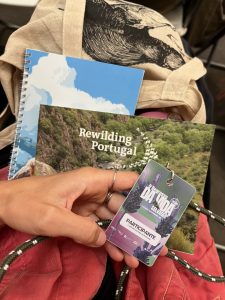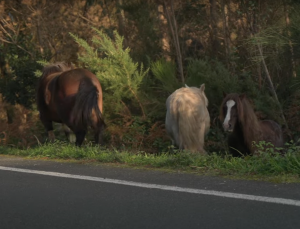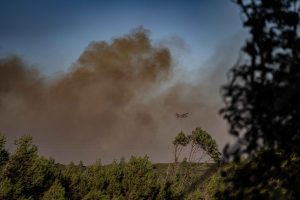A
Active rewilding: The restoration of ecosystems and ecological processes through deliberate human intervention, often involving the reintroduction of missing species or functional equivalents, and/or the removal of historical modifications such as drainage ditches.
Afforestation: The establishment of trees or woodland in areas lacking previous tree cover. See reforestation and natural regeneration.
Agriculture, extensive: A low-input agricultural system that utilizes minimal labor, fertilizers, and capital relative to the land area, often large and less productive.
Agriculture, intensive: An agricultural system characterized by high levels of input and output per unit area.
Anthropocene: The geological era in which human activity is considered the dominant influence on the Earth’s environment, climate, and ecology. It is commonly associated with the Industrial Revolution.
Apex predator: A predator occupying the highest trophic levels, with no natural predators of its own. Often influential in ecosystems and considered a keystone species.
Assisted colonisation: The deliberate translocation of species beyond their native range.
B
Back breeding: A structured breeding program aimed at restoring wild traits to domesticated species. An example is the controversial attempt by the Heck brothers in 1920s-30s Nazi Germany to create a breed of cattle resembling the extinct aurochs, known as Heck cattle.
Baseline survey: An ecological survey conducted at the project’s outset to collect information on the baseline status of species and ecosystem functioning before interventions, enabling comparisons over time.
Biodiversity: Short for biological diversity, encompassing the variability among living organisms and ecosystems. Often used as a catch-all term for all living species.
Bottom-up processes: Processes driven by resources (e.g., space and nutrients) and lower trophic forms, influencing higher trophic levels.
Browser: An animal that consumes leaves, soft shoots, and fruits, usually of trees and woody species. See also grazer.
Buffer area/zone: An area surrounding a core wilderness area where some human activity is permitted but still provides habitat for wildlife, facilitating a transition between wild nature and more intense human activity.
C
Carrying capacity: The maximum number of organisms an ecosystem can sustainably support without degradation, influenced by factors like food and water availability.
Connectivity: The degree to which habitats are connected, crucial for preventing fragmentation and promoting genetic diversity.
Consumer: Organisms that cannot produce their own food and must consume other organisms for nutrition. See also producer, decomposer.
Core wilderness area: A protected area where most or all human activities are restricted to preserve wildlife, habitat, and wilderness.
Corridors, habitat/wildlife: Areas linking larger wildlife areas, facilitating wildlife movement and preventing fragmentation. See connectivity.
Climax (vegetation) community: The final stage of ecological succession, dominated by a small number of prominent species, remaining stable until disrupted.
Cultural Reconnection: Fostering renewed connections between communities and the natural world, acknowledging the cultural importance of landscapes and biodiversity.
D
Decomposer: Organisms that consume dead plant and animal matter, converting it into energy and nutrients. Crucial for ecosystem functioning. See also producers and consumers.
De-extinction: The process of resurrecting species that have gone extinct, such as the controversial idea of bringing back the woolly mammoth.
Domestic proxy: A domesticated breed of animal used to replicate services provided by a wild animal. For example, Tamworth pigs fulfilling the ecological role of wild boar.
Driver (of change): Any factor, natural or human-induced, directly or indirectly causing ecosystem changes. Direct drivers unequivocally influence ecosystem processes, while indirect drivers operate more diffusely.
E
Eco-colonialism: Activities in the name of conservation infringing upon the rights, cultures, or traditions of a group, often indigenous, in the context of international relations and discussions on rewilding.
Ecological rewilding: Another term for passive rewilding.
Ecological remediation: The removal of pollution or contaminants from the environment, such as soil, ground or surface water pollution.
Ecosystem engineers: Species significantly altering, creating, or destroying habitats, often keystone species. Play a crucial role in maintaining biodiversity.
Ecosystem services: The benefits to humans provided by the natural environment and healthy ecosystems, such as clean air, food, and carbon capture.
Emergent properties: Properties that arise in a collection or complex system through interactions of individual members, which they do not possess independently. E.g., ant colonies exhibit emergent properties.
F
Fortress Conservation: A conservation model creating protected areas where ecosystems function isolated from humans, often excluding local people.
Functional diversity: A component of biodiversity related to the range of behavioral traits influencing ecosystem dynamics, creating rich, dynamic ecological communities with functional processes.
G
Grazer: An animal that consumes grasses and herbs. See also browser.
H
Habitat: The place, environment, or conditions where a plant or animal naturally lives and grows.
Herbivory: The consumption of plant material by animals. Herbivores are animals adapted to eat plants.
Holocene: The most recent geological epoch, beginning about 10,000 years ago, following the last glacial period.
Human rewilding: Encouraging the conscious undoing of human domestication, emphasizing regenerative land management techniques, and fostering deep connections with the natural world.
I
Invasive species: A non-native species spreading from its point of introduction and becoming abundant, negatively impacting the ecology of an area.
K
Keystone species: A species with a disproportionately large effect on its environment, often influencing the entire ecosystem and creating habitat for other species.
L
Land abandonment: The cessation of human use, management, or cultivation of land, often leading to ecological processes reinstatement. Associated with farmers abandoning marginal land.
Landscape-scale conservation: A holistic land management approach across a defined area, pursuing multiple benefits like water quality and biodiversity.
Land sharing: Low-yield farming maintaining biodiversity within the agricultural landscape but potentially threatening surrounding natural landscapes.
Land sparing: High-intensity agriculture requiring less land, leaving larger areas of wild habitat intact but posing threats to species with small home ranges.
M
Managed metapopulation: A group of populations connected by human management, overcoming dispersal barriers by translocating animals between populations.
Mega-fauna: Large animals in an area, habitat, or geological period, often referring to large-bodied terrestrial animals.
N
Natural capital: The world’s stock of natural resources, providing valuable benefits to humans through ecosystem services.
Natural Climate Solutions: Actions that increase carbon storage or avoid greenhouse gas emissions in landscapes across the globe, contributing to emission reduction goals.
Natural disturbance: Temporary changes in environmental conditions causing pronounced changes in an ecosystem. Major disturbances (e.g., fires, storms) can have significant effects on biodiversity.
Naturalistic grazing: Grazing aiming to replicate natural patterns, where herbivore populations fluctuate according to factors like food availability, allowing natural processes to act.
Natural process: Interactions among plants, animals, and non-living components, crucial for maintaining healthy ecosystems and biodiversity persistence.
Natural regeneration: The regeneration of trees and woodland through natural processes like seed dispersal, without human planting.
Nature-based tourism: Responsible travel to natural areas, aiming to conserve the environment and support local economies.
Nature connection: People’s subjective connection to the natural world, deepened through activities like sensory awareness, nature education, and observation.
P
Passive management: A low/non-intervention approach to land management.
Passive rewilding: The release of ecological processes resulting from humans ceasing to use, manage, or impact ecosystems. Associated with farmers abandoning marginal land, but may also be an intentional non-intervention approach to conservation.
Permaculture: Design principles centered on whole systems thinking, simulating or directly utilizing patterns observed in natural ecosystems, often applied to food growing and human systems.
Pleistocene: The earliest epoch of the Quaternary period, characterized by fluctuations in temperature, glacial and interglacial stages, and the appearance of Homo sapiens.
Pleistocene rewilding: An approach to active rewilding aiming to recreate functioning Pleistocene ecosystems, using proxy species where necessary.
Predation: The act of one animal preying on others.
Predation pressure: The effects of predation on a prey population, influencing the prey species’ survival.
Process-led conservation: An approach focusing on ecological processes rather than specified end-points. Rewilding is an example.
R
Reintroduction: The human-mediated movement of living organisms into an area where the species was historically native and has been made extinct.
Reforestation: The process of establishing trees or woodland in an area where there was previous tree cover. See afforestation and natural regeneration.
Regenerative farming/agriculture: Agriculture focusing on topsoil regeneration and conservation objectives like increasing biodiversity and improving water quality.
Restoration (ecological): The process of repairing ecosystems degraded, damaged, or destroyed by human activities.
Rewilding: The large-scale restoration of ecosystems where nature can self-regulate. Focuses on reinstating natural processes and, where appropriate, missing species. Contrast with ecological restoration.
Rootling/rooting: The action of digging in the ground, usually with the snout, for roots and invertebrates, especially seen in animals like wild boar and badgers.
S
Scrub: A habitat or plant community characterized by shrub domination, often transitional between open areas and woodland.
Seed source: The source of seed for planting or natural regeneration, representing the best available genetic material and local provenance.
Shifting Baseline Syndrome: The phenomenon where each generation perceives the environmental conditions of their upbringing as ‘normal,’ leading to a steady decline in standards for acceptable environmental conditions.
Succession: The sequence of ecological changes where one group of plant or animal species is replaced by another, part of the natural lifecycle of a landscape.
Sympathetic management: Outcome-led conservation management where humans mimic natural processes on sites with clear objectives.
T
Three Cs model: Cores, Corridors, and Carnivores’ model emphasized in rewilding approaches, highlighting the importance of apex predators.
Top-down processes: Processes driven by top-level consumers (predators) and their prey, influencing lower trophic forms.
Translocation (Conservation): The human-mediated movement of living organisms from one area to another, including reintroduction, reinforcement, and conservation introduction.
Trophic cascade: The propagation of indirect effects between nonadjacent trophic levels in a food chain or web, often driven from the top down.
Trophic downgrading: The loss of species occupying higher trophic levels, a human-induced trend since the late Pleistocene.
Trophic interaction: Feeding interactions between trophic levels, crucial for population abundance, ecological community structure, and ecosystem processes.
Trophic level: A group of organisms occupying the same level in a food chain, including primary producers, consumers, and decomposers.
Trophic rewilding: An ecological restoration strategy using species reintroductions to restore top-down processes, trophic interactions, and associated trophic cascades.
U
Urban rewilding: Applying rewilding principles to urban areas, focusing on integrating nature into cities through habitat corridors, green spaces, and biophilic design.
W
Wilding: Similar to rewilding but with more emphasis on creating new, wilder ecosystems and less emphasis on past trends and patterns.
Wood pasture: A high biodiversity value mosaic habitat consisting of open grassy areas, scrub, and denser woodland groves, often containing ancient open-grown trees and deadwood.





